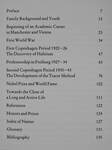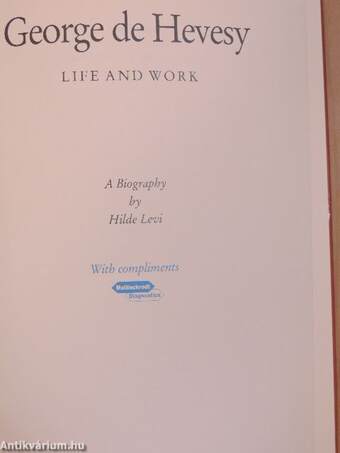1.115.393
kiadvánnyal nyújtjuk Magyarország legnagyobb antikvár könyv-kínálatát
George de Hevesy
Life and work
| Kiadó: | Szerzői magánkiadás |
|---|---|
| Kiadás helye: | Rodosz |
| Kiadás éve: | |
| Kötés típusa: | Vászon |
| Oldalszám: | 147 oldal |
| Sorozatcím: | |
| Kötetszám: | |
| Nyelv: | Német |
| Méret: | 25 cm x 17 cm |
| ISBN: | 87-7245-054-1 |
| Megjegyzés: | Fekete-fehér fotókkal. |
naponta értesítjük a beérkező friss
kiadványokról
naponta értesítjük a beérkező friss
kiadványokról
Fülszöveg
George de Hevesy Working in Lord Rutherford's laboratory in Manchester (1913) George de Hevesy, hungarian-born scientist, initiated the method of radioactive indicators as a tool in chemical analysis. After the First World War he spent six years at Niels Bohr's Institute in Denmark and, together with the Dutch physicist D. Coster, discovered a hitherto unknown element which was given the Latin name of Copenhagen: »Hafnium«. In the 1930s Hevesy returned to Copenhagen and developed the tracer technique using artificially produced radioactive isotopes in biological and medical research. The wide applicability of this technique triggered spectacular advances in the life sciences and many other branches of science and technology. Hevesy was awarded the Nobel Prize in 1944. The author Hilde Levi, a Ph.D. in physics from the University of Berlin began her scientific career at Niels Bohr's Institute of Theoretical Physics in Copenhagen in 1934. She was an assistant to George Hevesy and... TovábbFülszöveg
George de Hevesy Working in Lord Rutherford's laboratory in Manchester (1913) George de Hevesy, hungarian-born scientist, initiated the method of radioactive indicators as a tool in chemical analysis. After the First World War he spent six years at Niels Bohr's Institute in Denmark and, together with the Dutch physicist D. Coster, discovered a hitherto unknown element which was given the Latin name of Copenhagen: »Hafnium«. In the 1930s Hevesy returned to Copenhagen and developed the tracer technique using artificially produced radioactive isotopes in biological and medical research. The wide applicability of this technique triggered spectacular advances in the life sciences and many other branches of science and technology. Hevesy was awarded the Nobel Prize in 1944. The author Hilde Levi, a Ph.D. in physics from the University of Berlin began her scientific career at Niels Bohr's Institute of Theoretical Physics in Copenhagen in 1934. She was an assistant to George Hevesy and their collaboration continued until - after the Second World War - the tracer work was moved to the biology division of Copenhagen University. At that time George Hevesy settled in Sweden. Hilde Levi pursued her research and teaching activities untill her retirement and is at present an eager amateur histórián at the Archive of the Niels Bohr Institute in Copenhagen. VisszaTémakörök
- Életrajz > Tudomány > Tudósok
- Idegennyelv > Idegennyelvű könyvek > Német > Természettudomány > Fizika
- Idegennyelv > Idegennyelvű könyvek > Német > Természettudomány > Kémia
- Idegennyelv > Idegennyelvű könyvek > Német > Életrajz > Tudomány > Tudósok
- Természettudomány > Fizika > Atom- és magfizika > Radioaktivitás
- Természettudomány > Fizika > Idegennyelvű
- Természettudomány > Fizika > Társtudományok > Kémia
- Természettudomány > Kémia > Idegennyelvű
- Természettudomány > Kémia > Kémikusok, tudósok
- Természettudomány > Kémia > Társtudományok > Fizika
- Természettudomány > Kémia > Története
Hilde Levi
Hilde Levi műveinek az Antikvarium.hu-n kapható vagy előjegyezhető listáját itt tekintheti meg: Hilde Levi könyvek, művekMegvásárolható példányok
Nincs megvásárolható példány
A könyv összes megrendelhető példánya elfogyott. Ha kívánja, előjegyezheti a könyvet, és amint a könyv egy újabb példánya elérhető lesz, értesítjük.












